The rare Bermuda Petrel is nesting in record numbers this year on Nonsuch Island, where a translocation project has established a viable population in predator-free surroundings. A census earlier this month found a total of 117 breeding pairs (counted as those producing an egg, whether it hatched or not), up by two pairs compared to last year. By mid-April at least 62 chicks were present, so that, even with one or two losses before fledging in late May and early June, it seems likely the previous record of 59 fledged chicks in 2014 will be broken.
Endemic to its eponymous island, Bermuda Petrel — or Cahow — is thought to have been an abundant breeder throughout Bermuda in historical times. Settlement of the archipelago at the beginning of the 17th century saw a drastic population decline attributed to habitat loss, exploitation and predation, and the species was believed extinct for three centuries until it was rediscovered in the first half of the 20th century. In 1951, a tiny relict population of 18 pairs was found breeding on rocky islets in Castle Harbour, and intensive management over subsequent decades resulted in the overall population reaching 71 pairs with 35 young fledged in 2005, when the total number of birds was estimated at 250.
A translocation project to establish a new population of petrels on Nonsuch Island took place over several years, with 21 chicks from other islands being the last to be moved there in May 2008. The following year 14 individuals that had fledged on Nonsuch after translocation in 2005 and 2006 returned to the island and entered artificial burrows; ringing recoveries indicate that birds first return to breed four years after fledging. This year, local ornithologist Jeremy Madeiros reports that at least nine or 10 new nests are being prospected by newly matured young petrels returning to the nesting grounds for the first time since fledging, with established pairs confirmed in most of them. These potential new pairs will hopefully produce their first eggs in spring 2018.

Bermuda Petrel, at sea, Kerry (Photo: Ryan Wilson-Parr)
According to BirdLife International, recovery has been hampered to varying degrees by competition for nest sites from White-tailed Tropicbird, increased storm activity leading to flooding of burrows, occasional predation by rats (now eradicated) which have swum out to nesting islets, and in one instance by Bermuda's first Snowy Owl, which ate 5 per cent of the population on Nonsuch Island before it had to be killed.
After the breeding season, birds move out into the Atlantic, following the warm waters of the Gulf Stream as far north as the Bay of Fundy in south-easternmost Canada. Recent geolocator studies have also revealed previously unknown foraging areas in the central Atlantic, with some individuals ranging north-east to within 125–150 miles of Ireland and Spain. In November 2002 one was captured twice in a burrow on the Azores; it returned in November the following year and again in December 2006. More recently there was visual confirmation of geolocator findings when one was photographed at sea west of Kerry, Ireland, on 19 May 2014, the first 'in the field' record for the Western Palearctic.




